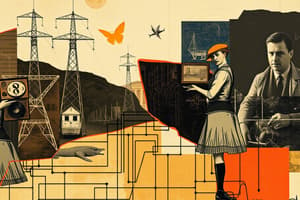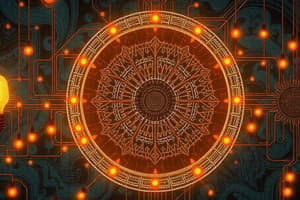Podcast
Questions and Answers
What is the unit of measurement for resistance?
What is the unit of measurement for resistance?
- Volts (V)
- Amperes (A)
- Ohms (Ω) (correct)
- Watts (W)
According to Ohm's Law, how is voltage related to current and resistance?
According to Ohm's Law, how is voltage related to current and resistance?
- V = I/R
- V = I + R
- V = R/I
- V = IR (correct)
In a series circuit, what is the relationship between current and resistance?
In a series circuit, what is the relationship between current and resistance?
- Current increases with resistance.
- Current decreases with an increase in voltage.
- Current is divided among components.
- Current is the same across all components. (correct)
What is the formula for calculating total resistance in a parallel circuit?
What is the formula for calculating total resistance in a parallel circuit?
Which of the following equations relates power, current, and potential difference?
Which of the following equations relates power, current, and potential difference?
What happens to electrical energy as it is transferred to other forms of energy?
What happens to electrical energy as it is transferred to other forms of energy?
Which of the following is a common electrical hazard?
Which of the following is a common electrical hazard?
What does the symbol of a lamp represent in circuit diagrams?
What does the symbol of a lamp represent in circuit diagrams?
Flashcards
What is electric current?
What is electric current?
The rate at which electric charge flows past a point in a circuit. It's measured in amperes (A).
What is potential difference?
What is potential difference?
The potential difference between two points in a circuit is the work done per unit charge in moving a charge from one point to another. It's measured in volts (V).
What is resistance?
What is resistance?
The opposition to the flow of electric current. It's measured in ohms (Ω).
What is Ohm's Law?
What is Ohm's Law?
Signup and view all the flashcards
What is a series circuit?
What is a series circuit?
Signup and view all the flashcards
What is a parallel circuit?
What is a parallel circuit?
Signup and view all the flashcards
What is electrical power?
What is electrical power?
Signup and view all the flashcards
How is electrical energy transformed?
How is electrical energy transformed?
Signup and view all the flashcards
Study Notes
Current, Potential Difference, and Resistance
- Current (I) is the rate of flow of charge. Measured in amperes (A).
- Potential difference (V) is the energy transferred per unit charge. Measured in volts (V).
- Resistance (R) is the opposition to the flow of current. Measured in ohms (Ω).
Ohm's Law
- Ohm's Law states that the current through a conductor between two points is directly proportional to the voltage across the two points.
- Mathematically expressed as: V = IR, where V is voltage, I is current, and R is resistance.
- This relationship holds true for many materials under constant temperature.
Series Circuits
- Components are connected end-to-end.
- Current is the same through all components in a series circuit.
- Total resistance in a series circuit is the sum of the individual resistances. Rtotal = R1 + R2 + R3...
Parallel Circuits
- Components are connected with separate branches.
- Potential difference (voltage) is the same across each component in a parallel circuit.
- The inverse of the total resistance is the sum of the inverses of the individual resistances. 1/Rtotal = 1/R1 + 1/R2 + 1/R3...
Power
- Power (P) is the rate at which energy is transferred or the rate at which work is done. Measured in watts (W).
- The formula relating power, current, and potential difference is: P = IV.
- Also, power can be related to current and resistance: P = I2R, and P = V2/R
Energy Transfer
- Electrical energy can be transferred into other forms of energy, such as heat, light, or kinetic energy.
- The amount of energy transferred depends on the power and the time the appliance is used. The formula is, Energy = Power × time.
Electrical Safety
- Electrical hazards include frayed wires, damaged plugs, overloaded circuits, and exposed wires.
- Short circuits can cause high currents that can lead to fires or damage devices.
- Using fuses or circuit breakers can protect against accidental short circuits by interrupting the current flow.
Circuit Symbols
- Symbols on circuit diagrams represent different components.
- Know the symbols for: cell, battery, wire, lamp, resistor, switch, ammeter, voltmeter, fuse.
Studying That Suits You
Use AI to generate personalized quizzes and flashcards to suit your learning preferences.




